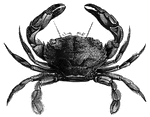Clipart tagged: ‘crustacea’

Amphipoda
An order of sessile-eyed malacostracan crustaceans, with feet directed partly forwards and partly backwards.…

Amphipoda
An order of sessile-eyed malacostracan crustaceans, with feet directed partly forwards and partly backwards.…

Common European crab
"These have the shell regularly rounded in front and narrowed behind; the legs are of moderate length,…

Fiddler Crab
A crab having one claw much larger than the other. As they walk sideways, they hold up the large claw…

Horseshoe Crab
Horseshoe crabs represent an order called Xiphosura, from the fact that the end of the abdomen is furnished…

King crab
"It is among the largest of crustaceous animals, sometimes measuring as much as two feet in length.…

Spider-Crab
Crabs are ten-footed crustaceans. The abdomen is tucked out of site, so that nothing is visible except…

Crustacea
Types of the Lower Crustacea. 1, Balanus; 2, Cytherea lutea; 3, Dapania pulex; 4, Lepus anatifera; 5,…

Lobster
Common lobster. I. first pair of legs; 2 and 3. second and third pairs of legs; 4 and 5. last two pair…

Wood Louse
Wood-lice are commonly found under stones or in crevices of old walls. When disturbed, they curl up…

Wood Louse
Wood-lice are commonly found under stones or in crevices of old walls. When disturbed, they curl up…

Sand-hopper
"The Common Sand-hopper, Talitrus locusta, which may be met with in thousands upon thousands…







